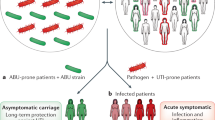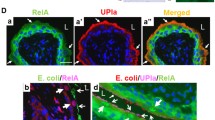Abstract
The role of innate immunity in the prevention of urinary tract infection is well-documented. Toll-like receptor 4 (TLR4) is a major determinant of innate immune response. In an animal model of urinary tract infection, bactofection-mediated gene transfer of TLR4 was tested in a preventive approach. Bactofection with TLR4 reduced the colonization with uropathogenic Escherichia coli by 91% in the kidney and by 41% in the bladder. Reduced colonization was associated with lower oxidative stress and expression of monocyte chemoattractant protein-1 and myeloperoxidase in the kidney. Bactofection with TLR4 was successful in the prevention of ascending pyelonephritis. Further studies should focus on long-term effects, the dose response and the potential therapeutic use in models of chronic urinary tract infection.



Similar content being viewed by others
References
Foxman B (2002) Epidemiology of urinary tract infections: Incidence, morbidity, and economic costs. Am J Med 113:5S–13S
Good DW, George T, Watts BA (2009) Lipopolysaccharide directly alters renal tubule transport through distinct TLR4-dependent pathways in basolateral and apical membranes. Am J Physiol Renal Physiol 297:F866–F874
Gupta K, Hooton TM, Stamm WE (2001) Increasing antimicrobial resistance and the management of uncomplicated community-acquired urinary tract infections. Ann Intern Med 135:41–50
Hu KK, Boyko EJ, Scholes D, Normand E, Chen CL, Grafton J, Fihn SD (2004) Risk factors for urinary tract infections in postmenopausal women. Arch Intern Med 164:989–993
Hung CS, Dodson KW, Hultgren SJ (2009) A murine model of urinary tract infection. Nat Protoc 4:1230–1243
Chassin C, Vimont S, Cluzeaud F, Bens M, Goujon JM, Fernandez B, Hertig A, Rondeau E, Arlet G, Hornef MW, Vandewalle A (2008) TLR4 facilitates translocation of bacteria across renal collecting duct cells. J Am Soc Nephrol 19:2364–2374
Medzhitov R (2001) Toll-like receptors and innate immunity. Nat Rev Immunol 1:135–145
Munch G, Keis R, Wessels A, Riederer P, Bahner U, Heidland A, Niwa T, Lemke HD, Schinzel R (1997) Determination of advanced glycation end products in serum by fluorescence spectroscopy and competitive ELISA. Eur J Clin Chem Clin Biochem 35:669–677
Nielubowicz GR, Mobley HLT (2010) Host-pathogen interactions in urinary tract infection. Nat Rev Urol 7:430–441
Ohkawa H, Ohishi N, Yagi K (1978) Reaction of linoleic acid hydroperoxide with thiobarbituric acid. J Lipid Res 19:1053–1057
Palffy R, Gardlik R, Hodosy J, Behuliak M, Resko P, Radvansky J, Celec P (2006) Bacteria in gene therapy: bactofection versus alternative gene therapy. Gene Ther 13:101–105
Ragnarsdottir B, Fischer H, Godaly G, Gronberg-Hernandez J, Gustafsson M, Karpman D, Lundstedt AC, Lutay N, Ramisch S, Svensson ML, Wullt B, Yadav M, Svanborg C (2008) TLR- and CXCR1-dependent innate immunity: insights into the genetics of urinary tract infections. Eur J Clin Invest 38:12–20
Ragnarsdottir B, Samuelsson M, Gustafsson MCU, Leijonhufvud I, Karpman D, Svanborg C (2007) Reduced toll-like receptor 4 expression in children with asymptomatic bacteriuria. J Infect Dis 196:475–484
Weichhart T, Haidinger M, Horl WH, Saemann MD (2008) Current concepts of molecular defence mechanisms operative during urinary tract infection. Eur J Clin Invest 38:29–38
Witko-Sarsat V, Friedlander M, CapeillereBlandin C, NguyenKhoa T, Nguyen NT, Zingraff J, Jungers P, DescampsLatscha B (1996) Advanced oxidation protein products as a novel marker of oxidative stress in uremia. Kidney Int 49:1304–1313
Yin XL, Chen L, Liu Y, Yang JL, Ma CQ, Yao ZY, Yang LJ, Wei L, Li MY (2010) Enhancement of the innate immune response of bladder epithelial cells by Astragalus polysaccharides through upregulation of TLR4 expression. Biochem Biophys Res Commun 397:232–238
Acknowledgments
This study was funded by the Slovak Research and Development Agency (SRDA)—grant APVV-0117-07. The authors are grateful to Prof. Ivan Pecháň (1932–2010) for great help in establishing the analysis of oxidative stress markers.
Conflict of interest
None.
Author information
Authors and Affiliations
Corresponding author
Rights and permissions
About this article
Cite this article
Tóthová, Ľ., Hodosy, J., Kamodyová, N. et al. Bactofection with Toll-Like Receptor 4 in a Murine Model of Urinary Tract Infection. Curr Microbiol 62, 1739–1742 (2011). https://doi.org/10.1007/s00284-011-9922-4
Received:
Accepted:
Published:
Issue Date:
DOI: https://doi.org/10.1007/s00284-011-9922-4




